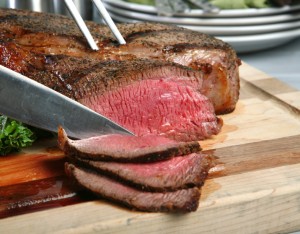In its June 2013 issue, Consumer Reports is tackling the issue of mechanically tenderized beef and E. coli illnesses. Food Poisoning Bulletin has told you about this issue before. Mechanically tenderized beef, which is a cut of beef that has been pierced with blades or needles to tenderize it, has been responsible for at least five E. coli O157:H7 outbreaks between 2003 and 2009.
 The problem is that while the interior of muscle cuts of beef do not usually contain bacteria, pathogenic bugs such as E. coli and Salmonella are on the surface. During slaughter, those bacteria from cow’s intestines spread all over. The blades and needles easily push the bacteria into the center of the meat. Then, when a steak is cooked rare or medium rare, pathogenic bacteria are not killed in the center of the cut. And someone gets sick.
The problem is that while the interior of muscle cuts of beef do not usually contain bacteria, pathogenic bugs such as E. coli and Salmonella are on the surface. During slaughter, those bacteria from cow’s intestines spread all over. The blades and needles easily push the bacteria into the center of the meat. Then, when a steak is cooked rare or medium rare, pathogenic bacteria are not killed in the center of the cut. And someone gets sick.
In 2003, the first documented outbreak was traced to blade-tenderized, marinade-injected frozen filet mignon steaks consumers coked at home. Thirteen people were sickened, seven hospitalized, and three died. In 2009, mechanically tenderized steaks sickened 25 people, hospitalizing nine and killing one person. In their report, Consumer Reports states, “these may not seem like large numbers, but cases reported as part of outbreaks represent only 10 to 25 percent of all lab-confirmed cases of E. coli O157:H7 that are reported annually by state and local health authorities.”
One of the problems with this issue is that consumers are willing to pay a premium for cuts they think are more tender. The report states that “a 10 percent increase in the tenderness of U.S. beef would increase U.S. beef industry income by up to $170 million annually.”
The USDA estimates that 37% of companies that slaughter or process beef use mechanically tenderization. Those products are not labeled and are not tested for E. coli. You can’t tell if a product has been mechanically tenderized by looking at it. And the USDA has acknowledged since 1999 that “customary cooking practices may not kill pathogens in beef that has been bladed or needled.” Last year, the USDA drafted a rule that would require labeling with safe cooking instructions. In case you’re wondering, organic standards do not prohibit mechanical tenderizing.
To protect yourself and your family, look for beef that has been labeled. Costco labels its mechanically tenderized beef. Always cook mechanically tenderized beef to 160 degrees F or higher, just like a hamburger. The USDA recommends 145 degrees F. as a minimum internal temperatures for intact beef cuts, but that isn’t enough to kill bacteria in a steak that has been mechanically tenderized or injected with marinade. Always use a meat thermometer instead of judging doneness by color or texture. And let beef rest after you take it off the heat to let it cook further and kill off bacteria. Finally, always ask if the beef you are ordering in a restaurant has been mechanically tenderized. If it is, either have it cooked well done or order something else.




